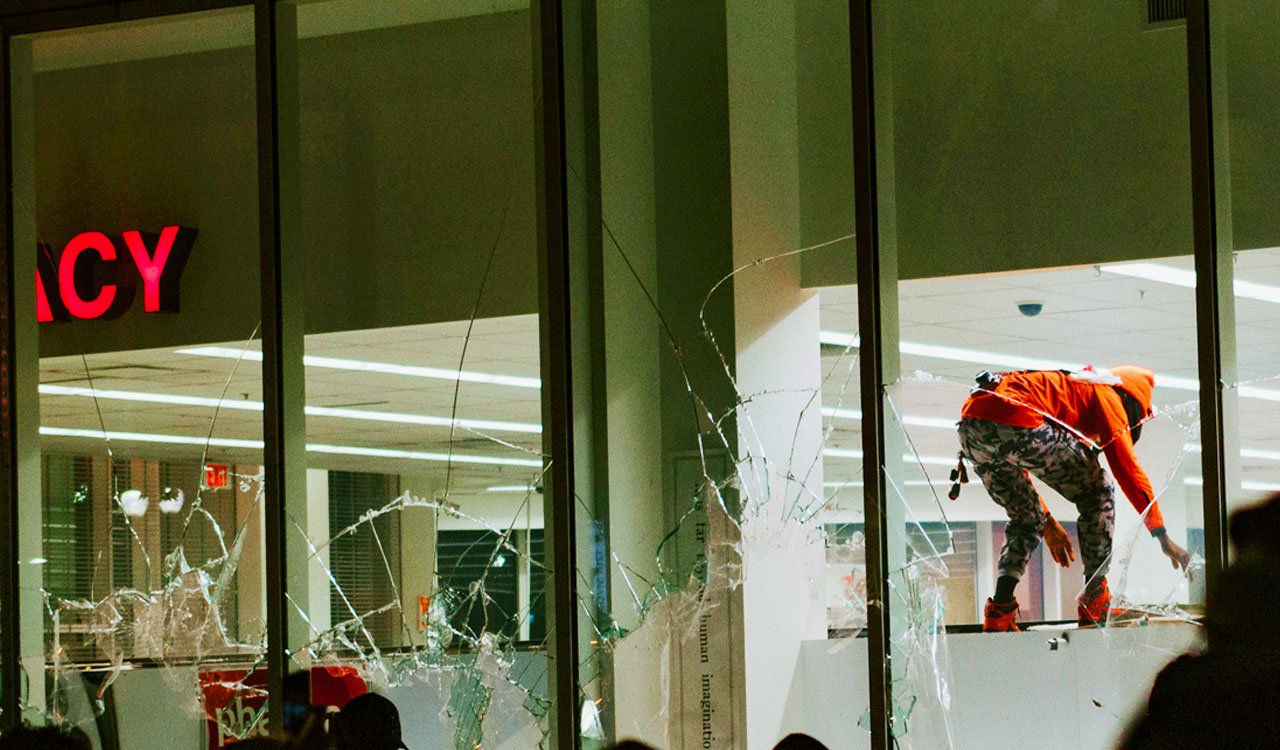After all the troubles retailers have had to contend with post-pandemic, including supply chain snafus, store staff gone MIA, rising interest rates, and inflation hitting 40-year highs that cut shoppers’ ability to spend, there’s another challenge to contend with organized retail crime (ORC).
Retail theft is no longer a nuisance where a watchful store employee can discourage a shoplifter. It’s become organized and increasingly violent with smash-and-grab mobs descending on stores to loot and pillage in near 9th-century Viking style, without the swords or helmets, but still with plenty of fearsome face masks and black hoodies. These marauders are armed with pepper spray and have fleets of getaway cars idling curbside to speed them away.
Menacing Marauders
Retail theft is no longer a nuisance where a watchful store employee can discourage a shoplifter. It’s become organized and increasingly violent with smash-and-grab mobs descending on stores to loot and pillage in near 9th-century Viking style, without the swords or helmets, but still with plenty of fearsome face masks and black hoodies. These marauders are armed with pepper spray and have fleets of getaway cars idling curbside to speed them away.
Under Attack
Recent high-profile attacks include a gang that rampaged Macy’s in the Westfield Fashion Square mall in Sherman Oaks, CA where pepper spray was used to fend off a security guard. Pepper spray and hammers were the weapons of choice in a Pasadena, CA jewelry store robbery where almost all its merchandise was lifted, totaling some $500,000 worth.
Luxury retailers have become favored targets because thieves can make off with more valuable loot. An Yves Saint Laurent store in Caruso’s Americana at Brand lifestyle center was hit at dinnertime. And a few days later, a Nordstrom store in the Westfield Topanga Mall in Woodland Hills was invaded with the mayhem caught on camera. All told thieves made off with nearly half a million dollars of loot in these two robberies.
“These are not victimless crimes, especially in the case where Angelenos were attacked through force of fear, as they did their jobs or ran errands,” said Los Angeles Mayor Karen Bass as she announced the formation of a 22-person strong investigative task force to address the growing problem across the city.
But it’s not just a Los Angeles or California problem. Major cities nationwide are seeing a rise in organized retail crime with New York, Houston, Miami, Chicago, Seattle, Atlanta and Dallas among the
top ten cities most affected, according to the National Retail Federation in a report co-sponsored by the Loss Prevention Research Council. The LPRC counts Walmart, Target, Gap, CVS, and Home Depot as founding members.
Retail Shrink Is Super-Sized Problem
The NRF estimates retail losses from theft, including ORC, will total some $100 billion this year, up from $90.8 billion in 2020, with some 70 percent of the retailers surveyed reporting the threat of ORC has grown over the past five years. A total of 63 retailers with a median sales volume of $2.5 billion were surveyed.
The losses are starting to show up on retailers’ balance sheets. Kohl’s, Dollar Tree, Home Depot, Ulta and Academy Sports & Outdoors all noted that theft is hurting business and cutting into margins. Dick’s Sporting Goods experienced a 23 percent drop in profitability in its most recent quarter partly due to a rapid rise in theft.
Target said shrink will cut profitability by more than $500 million this year and Walmart warned it could lead to higher prices for customers and possible store closures. Nordstrom CEO Erik Nordstrom reported in his August earnings call that losses from theft are at historic highs, adding that it is “impacting customer foot traffic in our stores and our ability to operate successfully.”
Despite the industry-wide monetary losses, retailers are most concerned about the violence associated with ORC. Over 80 percent of retailers surveyed reported criminals are more aggressive and violent now than they were a year ago, including 36 percent who said they were “much more” violent.
Co-Conspirators
Retailers point to the criminal justice system as contributing to the problem. Over 70 percent reported an increase in ORC crime when felony thresholds are lifted, as they have been in California where a thief can make off with up to $950 in merchandise in a single incident before being charged with a felony. And the reduction or elimination of cash bail has further emboldened offenders, according to 55 percent of retailers surveyed.
But the criminal justice system can’t take all the blame. LPRC’s research scientist
Cory Lowe, with a PhD in criminology, said that the police can’t act on retail crimes they know nothing about. He cited his firm’s latest “ORC Across the States 2022” survey that found about half of retail crimes go unreported. Retailers don’t bother reporting theft crimes to police primarily because they expect inaction or lack of follow-up (81 percent), and 63 percent believe prosecutors won’t prosecute such crimes.
But gang-related ORC is a different animal entirely. “Violence and organized retail crime problems are probably the greatest concerns among retailers right now,” Lowe shared with Investor’s Business Daily. And it’s a growing concern among consumers too.
Stop Thief!
Shoppers are increasingly concerned about rampant shoplifting and store looting in their communities. A survey conducted by NRF among n=5,000 consumers found 53 percent see an increase in retail crime in their neighborhoods, with the incidence growing to nearly 60 percent for urban dwellers.
Their greatest worry is the threat from gang-related shoplifting incidents (64 percent), which rises to 75 percent among consumers who live in urban communities. Consumers are not blind to the fact that rising retail theft will translate into higher prices (79 percent), and they share similar concerns as retailers about law enforcement and prosecutors being too lenient on retail criminals (51 percent).
Next Steps
The NRF has called on Congress to pass the Combating Organized Retail Crime Act which would devote more resources to fighting ORC and foster greater coordination among federal, state, and local law enforcement agencies to address it. Bi-partisan bills are now floating in the House and Senate and the NRF has launched a national
grassroots campaign in support of the Act.
It would go along with the INFORM for Consumers Act, passed last year, that requires online marketplaces, like eBay and Amazon, to collect, verify and disclose information from third-party sellers that conduct 200 transactions totaling $5,000 in revenues per year. Such marketplaces are a favored way to unload stolen merchandise.
David Johnston, NRF’s vice president of asset protection and retail operations, told Fox Business, “Online marketplaces have always been viewed as an avenue to anonymity and uncertainty as to who is actually selling the merchandise. Through the verification and validation required from the INFORM Act, it’s now going to remove that veil, not only for those that are investigating suspected items but also for consumers.”
However, Johnston acknowledged the INFORM Act and the proposed Combating Organized Retail Crime Act are still baby steps to stopping ORC. “It’s too early to tell how far the needle will move.”
Prevention Better Than the Cure
So far, retail criminals have stayed one or many steps ahead of retailers, but retailers are working to catch up. More retailers are turning to technology enhanced with AI capability to help their stores be less appealing targets.
Tech advances include video-surveillance systems, license-plate and vehicle identification systems, autonomous security robots, RFID tags, blockchain for luxury goods and facial recognition cameras – though how well they work to identify masked faces is questionable. And then the widespread use of facial recognition brings up a whole new set of problems surrounding privacy concerns.
AI can be layered onto existing systems to pinpoint suspicious behavior. “The first thing we look at is, can we detect these people and identify them before there are victims?”
Dr. Read Hayes, director of the LPRD, said to CNBC.
Since ORC gangs do advanced recognizance before committing their crimes, AI and facial recognition could help identify potential suspects before the act. Axis Communications has developed AI-assisted cameras that can analyze vehicle and individual activities outside the store to detect suspicious activity that can turn on strobe lights and a loud warning over a speaker.
The goal of having theft-prevention technology and security personnel front and center in the store is to make that location a less attractive target. “Thieves want the easiest job possible,” said technology reporter Dan Berhiaume of Chain Store Age. “If your store has some basic security protocols, they move on to a store that hasn’t been hardened.”
Working Together
In a recent
Retail Unwrapped podcast, Robin Lewis and Shelley Kohan met with George Shaw, founder, and CEO of Pathr.ai, to address the issue of rising retail crime. Observing simple measures like putting hot theft items under lock and key, Shaw said such efforts make “loss prevention become sales prevention” because shoppers find it not worth the time or effort to hunt down a salesclerk to unlock the display.
His company offers AI technology that can distinguish good shoppers from bad ones, so a previously locked case will automatically open for a shopper who doesn’t exhibit signs of being a shoplifter. He calls this and other AI-powered technology “spatial intelligence” that can work for retailers in loss prevention and asset management.
Fighting retail crime, organized or otherwise, is building bridges between unlikely partners, like fierce competitors Target and Walmart collaborating in the LPRD, and advanced technologists like Shaw and other scientists working with old-fashioned merchants to make their stores safe and secure.
“It takes a village to protect retailers’ assets,” said Kohan, and now local, state and the federal governments need to step up too to fight retail crime that is hurting retailers, the lifeblood of the American economy, and is of great concern of citizens who simply want to be safe and secure going about their everyday business, including when they shop.




